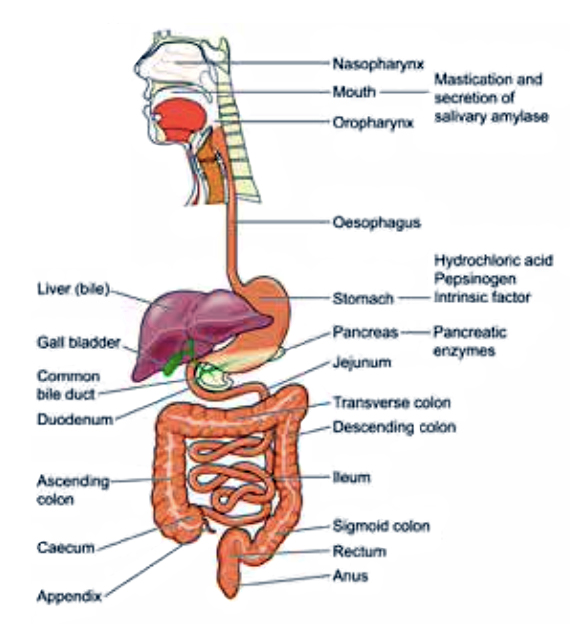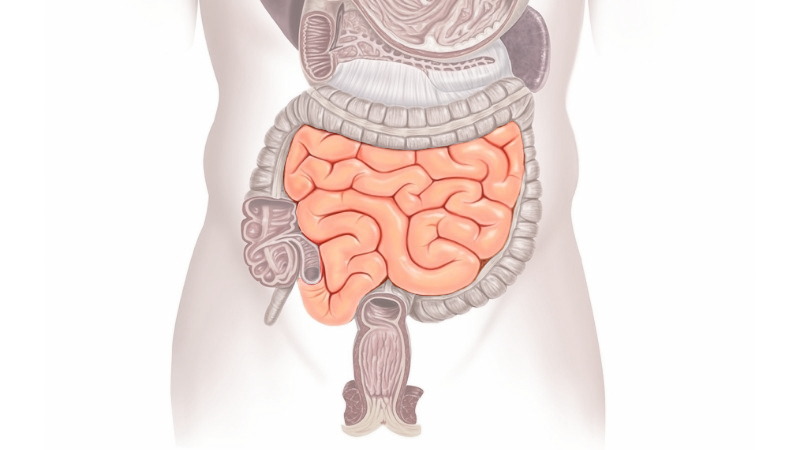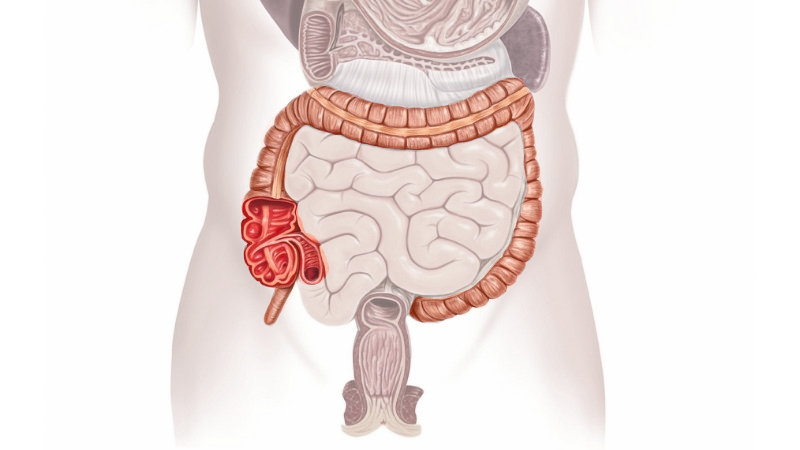what happens to your gut after you poop
The bowel is part of our digestive system and information technology works to digest the food we eat, absorb the goodness and nutrients into our blood stream, and so process and expel the waste that the torso cannot use.
The digestive system works by pushing food through the intestines which usually takes between 24 to 72 hours. Muscular contractions squeeze (peristalsis) the food through the different sections of the intestine. These different sections are separated past bands of muscles, or sphincters, which act as valves.
The passage of food from i surface area of the intestines to another is coordinated so that nutrient stays in a specific surface area for long plenty for the gut to do a particular job – absorb fluids and nutrients, or process and expel waste.

The small-scale bowel (pocket-size intestine)

The minor bowel (or minor intestine) is around 6 – eight m long and roughly 2cm wide.
There are iii parts of the small bowel (small intestine): the duodenum, the jejunum and the ileum.
Food passes from the stomach into the duodenum, which is the tube that leads from the stomach into the intestines. The food then passes through the jejunum and ileum before going to the large bowel (colon). The small bowel (pocket-sized intestine) absorbs nutrients and much of the liquid from foods. At the point where food is passed from the small-scale bowel into the big bowel (colon) it is of a 'porridge similar' consistency.
The Large Bowel (Colon – large intestine)

The big bowel (also known as the colon, or big intestine), starts at the final portion of the modest bowel (small intestine) and goes all the way to the rectum. The large bowel (colon) is well-nigh 2m long and 6-vii cm wide.
This muscular tube is fabricated up of the ascending colon, the transverse colon and the descending colon which ends at the rectum and the anus. The colon's most of import job is to store, process and get rid of waste. The colon too absorbs some nutrients and water. Key to this process are the hundreds maybe thousands of bacteria resident in the colon – both 'good' and 'bad' – which collectively make up the gut flora. The rectum can shop waste product but most of the time it's empty. Waste is expelled through the anus.
The rectum and muscles
One time the bowel has washed its work and absorbed nutrients from food, the waste travels to the rectum which stretches, triggering a bulletin to the brain to say that the bowel is total and needs to be emptied. The pelvic floor muscles, when well-toned, ensure the anus remains closed until it'southward fourth dimension to go to the toilet.
The rectum and anus
After nutrient has travelled along the gut, it has go digested and the nutrients and fluids captivated; the waste product is then expelled through the rectum and anus.
The rectum and the upper portion of the anal canal are richly supplied with nerves. When the rectum is full, the fretfulness sense this fullness and then inform the brain whether this is due to gas or stool.
When we need to go to the toilet, the brain tells the anal sphincter muscles, via the fretfulness, to relax. Equally the muscles relax, the anus opens and the rectum empties. In some neurological and spinal conditions the brain cannot tell whether the bowel is full of waste (faeces) or simply wind. This can atomic number 82 to accidental leakage.
Anal sphincters
The anal canal is nearly 3 – 4cm long in women and sometimes slightly longer in men. The internal and external sphincters form 2 concentric rings which run along the length of the anal canal.
The internal anal sphincter (IAS) is fabricated of smooth muscle and we do not accept voluntary command of this musculus. Information technology works automatically to go along the anus closed until we are ready to have a bowel move.
The external anal sphincter (EAS) is fabricated of striated musculus (the same as the pelvic flooring muscles); we do accept voluntary control over the EAS – allowing us to concord on if we are aware of wind or diarrhoea.
The pelvic floor muscle
The pelvic flooring muscles are layers of muscle stretched like a sheet from the pubic os in the forepart, to the bottom of the backbone (coccyx). There are 3 openings through the pelvic flooring in women and two in men -the anus (back passage), the vagina in women (birth canal) and the urethra (bladder outlet). The muscles support these 3 openings, but if they are weakened or not in good condition they cannot support the openings effectively.
An important role of the pelvic floor muscle regarding bowel control is the deepest layer called Levator Ani – which directly translated from Latin means 'lift the anus'. One of the musculus groups within levator ani is the puborectalis. This muscle forms a supportive strap around the junction between the rectum and the anal culvert and helps to keep us in control of our bowels by forming a flap like valve, which prevents stool passing too easily into the anal canal.
The sacral fretfulness
The brain tells the bowel what to do past sending electrical signals to the muscles in the pelvic floor, the sphincters and the urethra.
The commands from the brain to the bowel (colon) are sent as electrical impulses and are carried past a system of special fibres called nerves.
These signals beginning in the brain and go to the spinal cord and proceed to the nerves located in the sacral surface area of the back.
Some of these sacral nerves go to the rectum, levator ani muscle, and external sphincter muscles, decision-making their activities.
2 central sacral nerves that are vital to the functioning of the bowel are the pudendal nerve and the pelvic splanchnic nerve.
Through a serial of reflexes and signals the nerves in the bowel is coordinated with the pelvic flooring muscles and anal sphincters in guild to store bowel contents until there is an appropriate place to get to the toilet and and so to permit complete bowel emptying once on the toilet.
This coordination ensures that the sphincters remain closed, opening simply during defecation. So, when the rectum fills, and the force per unit area inside it increases, the nerves sense the pressure and tell the brain about it. The brain then sends signals via the nerves to keep the external sphincter closed. Normally, this prevents leakage and is called the guarding reflex.
When y'all need to become to the toilet, the brain tells the nerves to signal the rectum to empty, and relax the muscles surrounding the anus. The rectum empties and stool is expelled.
Sensory signals
The nervus pathways are likewise shared with fibres that acquit sensory signals, such as hurting or fullness. Hurting that originates in the pelvic surface area is transmitted forth these pathways to the sacral expanse, upwards the spinal string and dorsum to the brain.
The same happens every bit the rectum fills. This sensation of filling is registered by the nerves, which transmit the information to the brain.
The nerves can also tell the brain whether it'south gas or stool that's filling the rectum.
For the bowel to function and work properly, and to relieve constipation, you need:
- The nerves of the rectum and anus to exist sending the correct letters to your encephalon, and so that you can feel when stool or gas arrives in the rectum and tin send letters to the muscles you want to hold on. These may not function normally in some neurological and spinal weather and are sometimes damaged in childbirth.
- The internal and external anal sphincters demand to be working properly.
- The stools should not be as well soft or loose and so that the sphincters can cope with holding on, simply not so difficult so that they are difficult to pass.
- You need to exist able to go to and onto a toilet and to be able to agree on until the correct place is reached.
Source: https://www.bladderandbowel.org/bowel/bowel-resources/how-the-bowel-works/
0 Response to "what happens to your gut after you poop"
Post a Comment